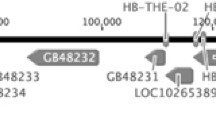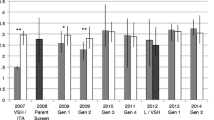Abstract
A colony-level phenotype was used to map the major sex determination locus (designatedX) in the honey bee (Apis mellifera). Individual queen bees (reproductive females) were mated to single drones (fertile males) by instrumental insemination. Haploid drone progeny of an F1 queen were each backcrossed to daughter queens from one of the parental lines. Ninety-eight of the resulting colonies containing backcross progeny were evaluated for the trait ‘low brood-viability’ resulting from the production of diploid drones that were homozygous atX. DNA samples from the haploid drone fathers of these colonies were used individually in polymerase chain reactions (PCR) with 10-base primers. These reactions generated random amplified polymorphic DNA (RAPD) markers that were analyzed for cosegregation with the colony-level phenotype. One RAPD marker allele was shared by 22 of 25 drones that fathered low brood-viability colonies. The RAPD marker fragment was cloned and partially sequenced. Two primers were designed that define a sequence-tagged site (STS) for this locus. The primers amplified DNA marker fragments that cosegregated with the original RAPD marker. In order to more precisely estimate the linkage betweenX and the STS locus, another group of bees consisting of progeny from one of the low-brood viability colonies was used in segregation analysis. Four diploid drones and 181 of their diploid sisters (workers, nonfertile females) were tested for segregation of the RAPD and STS markers. The cosegregating RAPD and STS markers were codominant due to the occurrence of fragment-length alleles. The four diploid drones were homozygous for these markers but only three of the 181 workers were homozygotes (recombinants). Therefore the distance betweenX and the STS locus was estimated at 1.6 cM. An additional linked marker was found that was 6.6 cM from the STS locus.
Similar content being viewed by others
References
Bull JJ (1981) Coevolution of haplo-diploidy and sex determination in the Hymenoptera. Evolution 35:568–580
Cline TW (1988) Evidence thatsisterless-a andsisterless-b are two of several discrete “numerator elements” of the X/A sex determination signal inDrosophila that switchSxl between two alternative stable expression states. Genetics 119:829–862
Cook JM (1993a) Sex determination in the Hymenoptera: a review of models and evidence. Heredity 71:421–435
Cook JM (1993b) Experimental tests of sex determination inGoniozus nephantidis (Hymenoptera: Bethylidae). Heredity 71:130–137
Crozier RH (1971) Heterozygosity and sex determination in haplodiploidy. Amer Naturalist 105:399–412
Erickson JW, Cline TW (1991) Molecular nature ofDrosophila sex determination signal and its link to neurogenesis. Science 251:1071–1074
Hartl DL, Brown SW (1970) The origin of male haploid genetic systems and their expected ratio. Theor Pop Biol 1:165–190
Horn AB (1943) Proof for multiple allelism of sex-differentiating factors inHabrobracon. Amer Nat 77:539–550
Hunt GJ, Page RE Jr (1992) Patterns of inheritance of RAPD molecular markers reveal novel types of polymorphism in the honey bee. Theor Appl Genet 85:15–20
Kosambi DD (1944) The estimation of map distances from recombination values. Ann Eugen 12:172–176
Laidlaw HH (1977) Instrumental Insemination of Honey Bee Queens. Dadant and Sons, Hamilton, Ontario
Laidlaw HH, el-Banby MA (1962) Inhibition of yellow body color in the honey bee,Apis mellifera L. J Hered 53:171–173
Laidlaw HH, Eckert JE (1962) Queen Rearing. University of California Press, Berkeley
Lander ES, Green P, Abrahamson J, Barlow A, Daly MJ, Lincoln SE, Newburg L (1987) MAPMAKER: an interactive computer package for constructing primary genetic linkage maps of experimental and natural populations. Genomics 1:174–181
Mackensen O (1951) Viability and sex determination in the honey bee (Apis mellifera L.). Genetics 36:500–509
Milne C (1986) Cytology and cytogenetics. In: Rendereir TE (ed) Bee Genetics and Breeding. Academic Press, New York, pp 205–233
Naito T, Suzuki H (1991) Sex determination in the sawfly,Athalia rosae ruficornis (Hymenoptera): occurrence of triploid males. J Hered 82:101–104
Olson M, Hood L, Cantor C, Botstein D (1989) A common language for physical mapping of the human genome. Science 245:1434–1435
Page RE (1986) Sperm utilization in social insects. Annu Rev Entomol 31:297–320
Paran I, Michelmore RW (1993) Development of reliable PCR-based markers linked to downy mildew resistance genes in lettuce. Theor Appl Genet 85:985–993
Parkhurst SM, Bopp D, Ish-Horowicz D (1990) X:A ratio, the primary sex-determining signal inDrosophila, is transduced by helix-loop-helix proteins. Cell 63:1179–1191
Periquet G, Hedderwick MP, El Agoze M, Poirie M (1993) Sex determination in the hymenopteranDiadromus pulchellus (Icheumonidae): validation of the one-locus multi-allele model. Heredity 70:420–427
Sanger F, Nicklen S, Coulson AR (1977) DNA sequencing with chain-terminating inhibitors. Proc Natl Acad Sci USA 74:5463–5467
Stouthamer R, Luck RF, Werren JH (1992) Genetics of sex determination and the improvement of biological control using parasitoids. Envir Entomol 21:427–435
Whiting PW (1940) Multiple alleles in sex determination ofHabrobracon. J Morphol 66:323–355
Whiting PW (1943) Multiple alleles in complementary sex determination ofHabrobracon. Genetics 28:365–382
Williams JGK, Kubelik AR, Livak KJ, Rafalski JA, Tingey SV (1990) DNA polymorphisms amplified by arbitrary primers are useful as genetic markers. Nucleic Acids Res 18:6531–6535
Woyke J (1963a) Drone larvae from fertilized eggs of the honey bee. J Apic Res 2:19–24
Woyke J (1963b) What happens to diploid drone larvae in a honey bee colony. J Apic Res 2:73–76
Woyke J (1969) A method of rearing diploid drones in a honeybee colony. J Apic Res 8:65–74
Woyke J (1977) The heredity of color patterns in the honey bee. International Symposium on Genetics, Selection and Reproduction of the Honey Bee. Apimondia, Bucharest 49–55
Woyke J (1986) Sex determination. In: Rinderer TE (ed) Bee Genetics and Breeding. Academic Press, New York, pp 91–119
Wright S (1939) The distribution of self-sterility alleles in populations. Genetics 24:538–552
Yokoyama S, Nei M (1979) Population dynamics of sex-determining alleles in honey bees and self-incompatibility alleles in plants. Genetics 91:609–626
Author information
Authors and Affiliations
Additional information
Communicated by B. H. Judd
Rights and permissions
About this article
Cite this article
Hunt, G.J., Page, R.E. Linkage analysis of sex determination in the honey bee (Apis mellifera). Molec. Gen. Genet. 244, 512–518 (1994). https://doi.org/10.1007/BF00583902
Received:
Accepted:
Issue Date:
DOI: https://doi.org/10.1007/BF00583902




